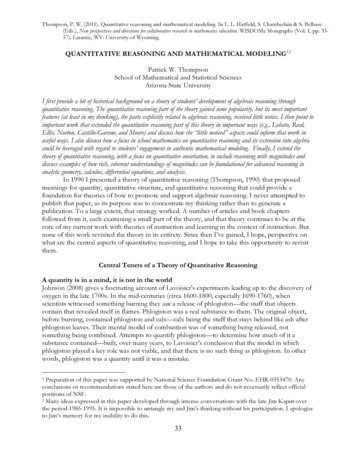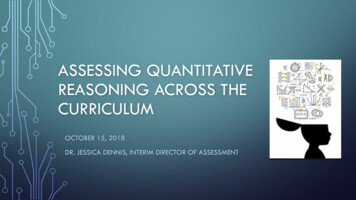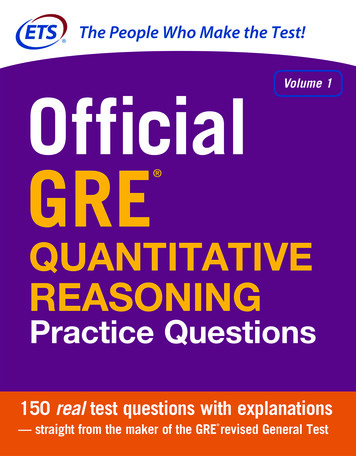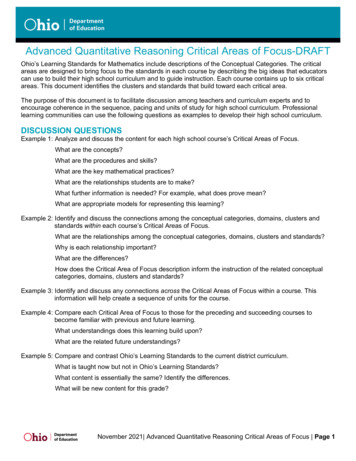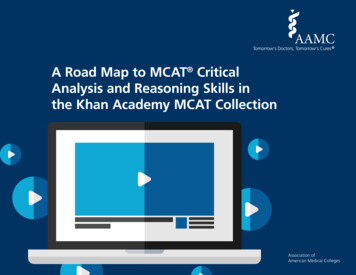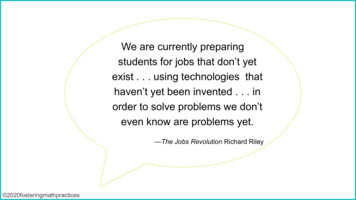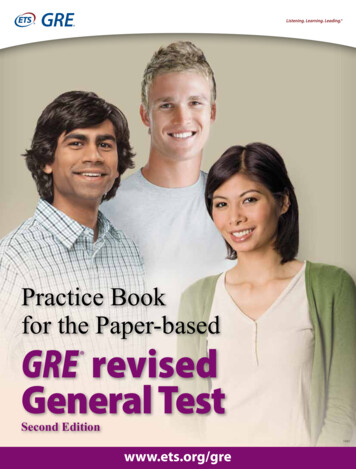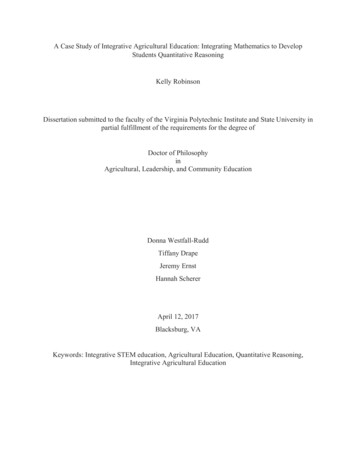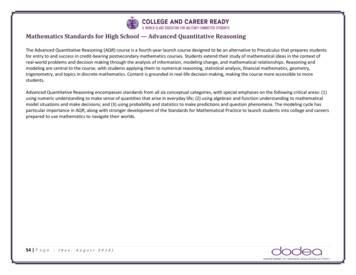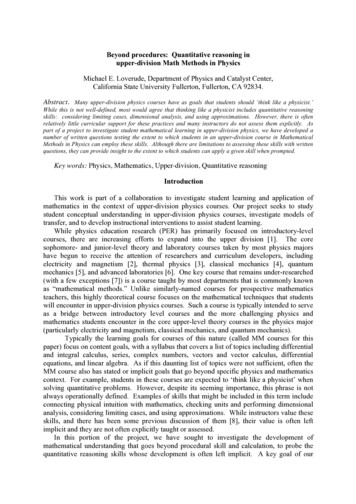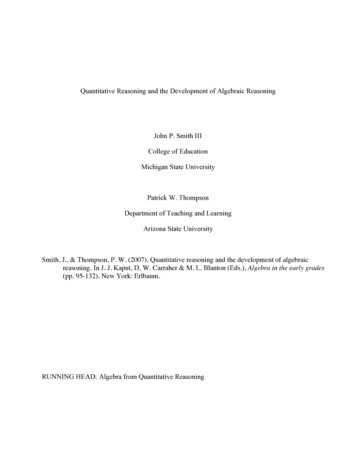
Transcription
Quantitative Reasoning and the Development of Algebraic ReasoningJohn P. Smith IIICollege of EducationMichigan State UniversityPatrick W. ThompsonDepartment of Teaching and LearningArizona State UniversitySmith, J., & Thompson, P. W. (2007). Quantitative reasoning and the development of algebraicreasoning. In J. J. Kaput, D. W. Carraher & M. L. Blanton (Eds.), Algebra in the early grades(pp. 95-132). New York: Erlbaum.RUNNING HEAD: Algebra from Quantitative Reasoning
Algebra from Quantitative Reasoning2AbstractRecent discussions of algebra reform have focused on having more students take algebra coursesand on improving their mathematical content. We believe that neither approach can be successfulwithout substantial changes in the K-8 mathematics curriculum's current focus on numbers andarithmetic operations. This curriculum does not prepare students for the use of explicit, rulegoverned notational systems to express, manipulate, and formalize ways of thinking aboutquantitative and numerical relationships. So students’ difficulties with algebra result not onlyfrom algebra curricula that lack meaning and coherence, but also from elementary curricula thatfail to develop students’ abilities to reason about complex additive and multiplicativerelationships. Without mathematical concepts and relationships to express and manipulate, manystudents find algebra a meaningless symbolic exercise. We argue that a focus on quantitativereasoning can develop students' abilities to conceptualize, reason about, and operate on quantitiesand relationships in sensible problem situations. We describe a broad view of quantitativereasoning as it relates to algebraic and arithmetical reasoning and show how it actually providescontent for algebra.
Algebra from Quantitative Reasoning3No doubt, it is difficult for a teacher to teach something whichdoes not satisfy him entirely, but the satisfaction of the teacher isnot the unique goal of teaching; one has at first to take care of whatis the mind of the student and what one wants it to become.(Poincaré, 1904, p. 255)IntroductionIn keeping with the theme of this book—the early development of algebraic knowledge andreasoning—we describe how students might develop knowledge and ways of thinking inelementary and middle school that support their learning of algebra. When we use the term,“algebra,” we are not referring to the content of the “Algebra I” course currently taught in mostAmerican middle and high schools. We mean the expression, manipulation, and formalization ofmathematical concepts and structures mediated by explicit, rule-governed notational systems. Assuch, the content of algebra, to us, depends on ideas of coherence, representation, generalization,and abstraction. To address the development of algebraic reasoning, especially a meaningful anduseful algebra, we must first address a more fundamental problem in mathematics teaching andlearning.For too many students and teachers, mathematics bears little useful relationship to theirworld. It is first a world of numbers and numerical procedures (arithmetic), and later a world ofsymbols and symbolic procedures (algebra). What is often missing is any linkage betweennumbers and symbols and the situations, problems, and ideas that they help us think about.Preparing students for algebra should not mean importing parts of an Algebra I course into theearlier grades. Rather, it should involve changing elementary and middle school curricula andteaching so that students come to use symbolic notation to represent, communicate, andgeneralize their reasoning.The opening quote from Poincaré highlights our central point. As we design an “earlyalgebra” program for elementary and middle school students, we must avoid the temptation tomake it resemble the algebra familiar to us as adults. There are too many problems withtraditional Algebra I in the US—perhaps the most serious of which is students' inability to find
Algebra from Quantitative Reasoning4meaning and purpose in it—to use it as a model for our efforts (Silver, 1997). For this reason, afresh approach is needed. Indeed, we must craft our expectations so that students build a kind ofalgebraic competence that is rich, generative, and multi-purpose.For most of us, “algebra” means the content of traditional “Algebra I” and the coursesthat follow it. For authors of Algebra I textbooks, algebra is a tightly integrated system ofsymbolic procedures, each of which is closely connected with a particular problem type. Theprocedures are often introduced as the mathematical means to solve specific types of problems,but the focus quickly becomes learning how to manipulate symbolic expressions. Theseprocedures are then practiced extensively and later applied to specific problem situations (thatis, “word problems”). Teaching this content involves helping students to interpret variouscommands—“solve,” “reduce,” “factor,” “simplify”— as calls to apply memorized proceduresthat have little meaning beyond the immediate context. For many students, this reduces algebrato a set of rituals involving strings of symbols and rules for rewriting them instead of being auseful or powerful way to reason about situations and questions that matter to them.Consequently, many students limit their engagement with algebra and stop trying to understandits nature and purpose. In many cases, this marks more or less the end of their mathematicalgrowth.Many mathematics educators have recognized the deep problems of content and impactof Algebra I and have made introductory algebra a major site in curricular reform efforts(Chazan, 2000; Dossey, 1998; Edwards, 1990; Fey, 1989; Heid, 1995; Phillips & Lappan, 1998).In one class of proposals, algebra is presented as a set of tools for analyzing realistic problemsthat outstrip students’ arithmetic capabilities. In contrast to Algebra I, problem situationsinvolving related quantities serve as the true source and ground for the development of algebraicmethods, rather than mere pretext (Chazan, 2000; Lobato, Gamoran, & Magidson, 1993; Phillips
Algebra from Quantitative Reasoning5& Lappan, 1998). These introductions to algebra aim to develop students’ abilities to use verbalrules, tables of values, graphs, and algebraic expressions to analyze the mathematical functionsembedded in the problem situations, and centrally involve computer-based tools and graphingcalculators to achieve these goals (Confrey, 1991; Demana & Waits, 1990; Heid, 1995; Schwartz& Yerushalmy, 1992).Other proposals have emphasized the abstract and formal aspects of mathematicalpractice, suggesting that introductory algebra should develop students’ abilities to identify andanalyze abstract mathematical objects and systems. For example, Cuoco (1993, 1995) hascharacterized algebra as the study of numerical and symbolic calculations and, through thedevelopment of a theory of calculation, the study of operations, relations among them (e.g.,distributivity), and mathematical systems structured by those operations. Cuoco's proposalreflects mathematicians’ interest in the study of increasing abstract and general algebraicsystems.Two working groups, directed to chart algebra reform K–12, have proposed a morepluralistic approach (National Council of Teachers of Mathematics Algebra Task Force; 1993;National Council of Teachers of Mathematics Algebra Working Group, 1997). They identifiedfour basic conceptual themes in current algebra reform proposals—functions and relations,modeling, structure, and representation and language—which in turn can be explored in variousmathematical contexts, such as growth and change, number, pattern and regularity (NationalCouncil of Teachers of Mathematics Algebra Working Group, 1997). Rather than mandate onebest introductory algebra, these educators anticipated different courses that emphasize differentthemes and draw from different contexts (see also, Bednarz, Kieran, & Lee, 1996). Kaput’s(1995) characterization of algebra and algebra reform was similarly pluralistic, identifying five
Algebra from Quantitative Reasoning6major strands of algebraic thinking which alternately focus on mathematical process(generalization, formalization, manipulation), content (structures, functions), and language.Given this proliferation of alternatives, one approach to “early algebra” would pick oneview of algebra and develop scaled-down introductory versions in earlier grades. For example,the current “Pre-Algebra” course common to middle schools is a scaled down version of AlgebraI. We suggest this would be a mistake. We believe it is possible to prepare children for differentviews of algebra—algebra as modeling, as pattern finding, as the study of structure—by havingthem build ways of knowing and reasoning which make those mathematical practices differentaspects of a more central and fundamental way of thinking. Alternative views of “what algebrais” can be seen as different emergent aspects of making sense of one’s world quantitatively. Toinvoke a biological metaphor, the development of quantitative reasoning can serve as theconceptual root stalk for many different approaches to “algebra.” Because the stalk can supportmultiple branches, wedding "early algebra" to one or another approach is unnecessary andlimiting.We advocate an early emphasis on developing children’s ability to conceive of, reasonabout, and manipulate complex ideas and relationships, as an equal complement to numericalreasoning and computation. Children who develop a rich capacity for reasoning about generalrelationships among quantities will possess the conceptual foundation for learning and makingsense of different programs and views of algebra. This chapter describes a conceptual orientationtoward “what is going on” in complex quantitative situations, showing how teachers can helpstudents make mathematical sense of those situations. The key claim in our argument is: Ifstudents are eventually to use algebraic notation and techniques to express their ideas andreasoning productively, then their ideas and reasoning must become sufficiently sophisticated towarrant such tools.
Algebra from Quantitative Reasoning7There is a reciprocal relationship between the long-term development of students’algebraic abilities and the long-term development of their reasoning from which these abilitiesemerge. If algebra, meaning the use of representational practices that employ systematic use ofsymbols to express quantitative and structural relationships, is to become students’ means ofexpressing and supporting their thinking, they must have experiences from whence the thinkingthat those practices support emerges. Likewise, if they are to develop thinking that calls forrepresentational practices that employ systematic use of symbols to express quantitative andstructural relationships, then the roots of those practices must be present in their early activities.Algebra, Situations, and QuantitiesFor the mathematically sophisticated, the best approach to complex mathematicalproblems is to use the tools of algebra to help manage that complexity.1 We move quickly awayfrom the problem situations themselves, with all their complex relationships, toward theformality of algebraic and numerical expressions and manipulations. In appealing to algebraicmethods to solve complex problems, we elect not to use less formal approaches that are tiedmore closely to the situation. We also tend to devalue this “informal” reasoning in comparison toalgebraic methods. In this devaluation, we miss an essential connection between the two kinds ofthinking: That more concrete, intuitive, and situation-specific patterns of reasoning,appropriately supported and nurtured over a period of years, can foster students' development ofthe algebraic reasoning we value so highly. If our goal is for students to understand and usealgebra, then the success of an “early algebra” program will depend on supporting thedevelopment of formal reasoning from an informal foundation.1 Mathematics educators use the term, “problem,” in various different ways. In this chapter, our “problems” aremathematical tasks suggested by verbal descriptions of situations constituted by interrelated quantities. Such“problem situations” can generate many “problems.” In students’ terms, our “problems” are always “word
Algebra from Quantitative Reasoning8To illustrate the common separation of formal, algebraic reasoning and informalreasoning, compare a traditional algebraic solution to the following problem to one that moredirectly involves the quantities and relationships in the problem situation.Problem 1.I walk from home to school in 30 minutes, and my brother takes 40minutes. My brother left 6 minutes before I did. In how many minutes will Iovertake him? (Krutetski, 1976, p. 160)A typical algebraic solution to this problem involves assigning variables, writingalgebraic expressions, and eventually stating and solving an equation. If t represents the numberof minutes I have walked, then whenever I have walked t minutes my brother will have walked t 6 minutes. If d stands for the number of miles from home to school, and if I and my brothertravel at constant speeds, then my walking speed is d/30 miles per minute and my brother’s isd/40 miles per minute. Using the general relationship that “rate multiplied by time equalsdistance” (d r*t), these expressions can be stated in the equation, (t 6)d/40 t d/30, whichcan be easily solved from its equivalent form, (t 6)/40 t/30. Related motion problems likeProblem 1 are common in algebra textbooks because algebraic methods are presumed necessaryto solve them. As long as no difficulties arise, this algebraic approach makes few explicitreferences to how speeds, times and distances are related in the situation. The basic idea is tomove out of the situation and its constituent quantities and into the world of symbolicexpressions and equations.But this problem can also be solved by reasoning about the relationships amongdistances, walking rates, and times of travel without the support of variable assignments oralgebraic expressions. Here is one example of this approach, which we will call “quantitativereasoning.”problems.” In addition, we follow Schoenfeld’s (1985) view that “problems,” in contrast to “exercises,” cannot besolved by routine, well-practiced methods. They require thinking.
Algebra from Quantitative Reasoning 9I imagine myself walking behind my brother, seeing him ahead of me. What matters incatching up with him is the distance between us and how long it takes for thatdistance to become zero. The distance between us shrinks at a speed that is the difference of our walkingspeeds. I take 3/4 as long as brother to walk to school, so I walk 4/3 as fast as brother. Since I walk 4/3 as fast as brother, the distance between us shrinks at the rate of 1/3of brother’s speed. The time required for the distance between us to vanish will therefore be 3 times aslong as it took brother to walk it in the first place (6 minutes). Therefore, I will overtake brother in 18 minutes.Like the algebraic solution, this reasoning is quite sophisticated, requiring a richunderstanding of how times, speeds, and distances are related, how those relationships can beused to draw inferences, and how numerical values can be inferred from those that are given. Italso has the same level of potential generality as the algebraic solution. If different initialnumerical values were given, the calculations in the solution might become more cumbersome,but the logic of the reasoning would not change. The two solutions differ most visibly in theiruse of algebraic symbols. However, they differ more deeply in the former’s focus on translatingrelationships into symbols and the latter’s focus on expressing and working directly with thoserelationships.In proposing quantitative reasoning as a root for algebraic thinking we acknowledge thatthe former does not develop easily or quickly. In fact, the student who produced this solutionachieved his proficiency from a wide variety of experiences over several years. Our thesis is thatstudents’ quantitative reasoning is worth years of attention and development, both because it
Algebra from Quantitative Reasoning10increases the likelihood of success with algebra and because it makes arithmetic and algebraicknowledge more meaningful and productive.Algebraic reasoning is characterized by its generality and by the role that symbolicexpressions play in stating general relationships, comparing and manipulating them, andfacilitating many numerical evaluations. Quantitative reasoning, when developed throughoutchildren’s elementary and middle school years, develops mathematical ideas of similar generalitythat students will eventually find sensible to express in algebraic notation. Put simply,quantitative reasoning provides conceptual content for powerful forms of representation andmanipulation in algebra.Before we proceed, it is important to emphasize that we are not using the terms“quantity” and “quantitative reasoning” as synonyms for “number” and “numerical reasoning.”Indeed, our central purpose below will be to show how the elementary years can be used tosupport the development of students’ quantitative reasoning by focusing their attention awayfrom thinking strictly about numbers and numerical operations. In our view, conceiving of andreasoning about quantities in situations does not require knowing their numerical value (e.g.,how many there are, how long or wide they are, etc.). Quantities are attributes of objects orphenomena that are measurable; it is our capacity to measure them—whether we have carriedout those measurements or not—that makes them quantities (Thompson, 1989; 1993; 1994). Inthis sense, we follow Piaget’s meaning of quantity and quantification (Piaget, 1952; 1970). Butas we do, we also acknowledge that other analysts draw much closer associations betweenquantity and number (e.g., Fey, 1990; Fuson, et al., 1997).Relationships Between Quantitative Reasoning and Algebraic ReasoningThe two prior solutions to Problem 1 suggest a stark contrast. One translated therelationships in the situation into traditional algebraic expressions and looked like “algebra;” the
Algebra from Quantitative Reasoning11other directly manipulated the relationships among the quantities in the situation—elapsed times,walking speeds, and walking distances. While this contrast exemplifies the character ofquantitative reasoning as a distinct form of mathematical thinking, we stress the connectionsbetween quantitative reasoning and algebra, as well as their differences. Before we consider howsuch sophisticated quantitative reasoning can be nurtured over the years, we return to Problem 1and examine three solutions in greater detail. These solutions (the two given above and onemore) show how quantitative reasoning can underlie and motivate reasoning with symbols.The traditional algebraic solution involved generating and solving the equation,(6 t)dd t . But what sort of thinking could motivate the initial variable assignments and4030the symbolic expressions for times and speeds found in that equation? If the equation writerunderstood the problem situation (rather than memorized a script for this problem type), his/herreasoning might have had some of the following character.2a. Since we both begin from home, I will catch my brother when we both have walked thesame distance from home.3We both walk any distance by traveling at some speed forsome amount of time.b. I do not know how far it is from home to school, but I can think of it as some number ofmiles, which I will designate by d. My brother walks d miles in 40 minutes, so hisddspeed ismiles per minute. I walk d miles in 30 minutes, so my walking speed is3040miles per minute.c. At any moment in my walk, I have walked tdmiles in t minutes. After I start, brother30will have walked for 6 minutes longer than I, so when I have walked t minutes, brother2We do not claim that all cases of reasoning sensibly with algebraic symbols follow these exact steps. This is onlyone example of sensible algebraic reasoning on this problem.3The reasoner assumes that the walkers follow the same path.
Algebra from Quantitative Reasoningwill have walked (t 6) mnutes. Therefore, he will have walked (t 6)12dmiles when I40have walked t minutes .d. I will catch brother when he and I have walked exactly the same distance from home.At that moment, our two distances will be the same, so the formula for his distance,dd(t 6) , and the formula for my distance, t , will have the same value. So, I am4030ddlooking for values of t that make the sentence (6 t) ttrue for any value of d.4030We consider this reasoning a good example of using algebra with “understanding.” Themain content of that understanding is a solid conceptual grasp of how the quantities of walkingspeeds, times traveled, and distanced traveled from home are interrelated. This elaboratedalgebraic solution differs from the first “bare-bones” one in that it (1) restates the problem interms of the reasoner’s own experience with relative motion, (2) sketches the logic fortransforming walking times into speeds, (3) sees the expressions for distanceas complete andcontinuous descriptions of motion, and (4) generates an equation to determine where thosedistance expressions produce the same value. Indeed, every step in the solution expresses someconceptual relationship between two or more quantities in the situation, and it is theserelationships that motivate and justify the various algebraic expressions. One role for quantitativereasoning in complex problem solving is therefore to provide the content for algebraicexpressions so that the power of that notation can be exploited.Another role of quantitative reasoning is to support reasoning that is flexible and generalin character but does not necessarily rely on symbolic expressions. We return to the nonalgebraic, quantitative solution of Problem 1 and unpack it to show how such sophisticatedreasoning might grow and how it shares the generality that characterizes algebraic reasoning. I imagine myself and my brother walking. What matters in catching up with him is thedistance between us and how long it takes for that distance to vanish.
Algebra from Quantitative Reasoning13The reasoner projects herself into the problem situation, adopting the perspective ofactually looking at her brother walking ahead of her. From this perspective, her distance andbrother’s distance from home are irrelevant, and the only thing that matters is the distancebetween them. It is this step of imagining oneself into the problem situation that so often eludesstudents. The distance between us shrinks at a rate that is the difference of our walking speeds.This is quite a sophisticated inference. When two quantities change at constant rates, inthe same direction, and we consider how rapidly their measures move apart, we are asking atwhat rate the difference between them changes. If we consider each one changing for a unit oftime, then the added difference will be the difference of their rates. Thus, the rate at which theexcess of one over the other changes is the difference of the two quantities’ rates. In terms ofdistance and speed, the rate at which the distance between the walkers changes is the differenceof their walking speeds. We hasten to add that by difference we do not mean the result ofsubtracting. Rather, we mean the distance that is created by comparing how much one distanceexceeds or falls short of the other. I take 3/4 as long as brother to walk to school, so I walk 4/3 as fast as brother.This is another sophisticated inference. It exploits a general understanding of speed as arate of change of distance with respect to changes in time. Because we walk the same distance,our walking speeds are different only because our travel times are different. Longer travel timesmean slower walking speeds. If I walk the same distance as brother in 3/4 the time, then I wouldwalk 1/3 again as far as brother in the same amount of time (Figure 1). So I walk 4/3 as fast asbrother because I walk four one-thirds (4/3) as far as brother in the same amount of time.
Algebra from Quantitative Reasoning14Figure 1. Relating my speed to brother’s speed based on the relationship of my time to his. Since I walk 4/3 as fast as brother, the distance between us shrinks at the rate of 1/3of brother’s speed.Walking 4/3 as fast as brother means that my speed is 1/3 greater than my brother’sspeed. So, in a given amount of time, I not only walk as far as brother, I walk an extra one-thirdof the distance he has walked. Therefore, the distance between us shrinks at the rate of one-thirdof brother’s speed. The time required for the distance between us to vanish will therefore be 3 times aslong as it took brother to walk it in the first place (which was 6 minutes).If brother took some amount of time to walk some distance, and another person walked atone-third of brother’s speed for the same amount of time, then that person will walk one-third ofthe distance brother walked. So, in 6 minutes, the amount of time brother used to get ahead ofme, the distance between us will shrink by 1/3 of the distance he walked in 6 minutes. I need toshrink this distance 3 times, so it takes me 3 times 6 minutes, or 18 minutes, to catch brother. Therefore, I will overtake brother in 18 minutes.
Algebra from Quantitative Reasoning15This solution illustrates some important features of quantitative reasoning and its origins.First, quantitative reasoning draws heavily on everyday experience. The basic approach—studying how the distance between the walkers decreases—depends on the reasoner projectingherself into the situation and invoking the visual imagery of “catching up.” Once framed in thatway, the solution proceeds by drawing on relationships among speeds, times, and distances. Thechange in distance-between-walkers is cast as a rate of change and expressed in terms of thebrothers’ walking speeds, and numerous quantitative manipulations of the speed-time-distancerelationship support numerical inferences about the value of various quantities. Finally, though itis grounded in everyday experience, it is difficult to imagine how students could develop thislevel of facility without focused instruction which draws on and stretches their abilities to stategeneral relationships and make inferences from them.We do not offer this solution as paradigmatic of “quantitative reasoning.” Indeed,quantitative reasoning does not typically follow any standard pattern or routine like the variableassignment and equation solving in traditional algebraic problem solving. Quantitatively-orientedsolutions tend to vary more widely than algebraic solutions to the same problem, primarilybecause they are grounded in how students conceive of situations, and there is tremendous rangein these conceptions. To illustrate this variety we present another quantitative solution toProblem 1 produced by a less mathematically mature student. This student’s reasoning was lessgeneral but grounded in a solid, concrete understanding of constant speed as a rate of change. Imagine the distance from home to school cut up into 30 pieces. Each piece is how farI walk in one minute. Imagine the distance from home to school also cut up into 40 pieces. Each of thesepieces is how far brother walks in one minute.
Algebra from Quantitative Reasoning 16Brother’s one-minute-distance piece will be 3/4 the length of my one-minute-distancepiece.This statement directly compares the length of the one-minute-distance to brother’s one-minutedistance. In six minutes, Brother will travel six [of his one-minute distances], so he will travel18/4 of my one-minute-distance piece. That is how far ahead of me brother is.Six iterations of 3/4 of my one-minute-distance piece is 18/4 of my one-minute-piece. When I start walking, I will move closer to brother by 1/4 of my one-minute-distancepiece each minute.If for every one-minute-distance piece I move brother moves 3/4 of that one-minute-distancepiece, then I am gaining by the difference each minute. I will make up 18/4 (eighteen one-fourths) of my one-minute-distance piece in 18minutes when I gain on brother at the rate of 1/4 one-minute-distance piece eachminute.Several features of this solution are worth highlighting. Though it may appear entirely“arithmetical” and “concrete,” it involves quantities whose actual values are unknown (distancefrom home to school, “my” one-minute-distance, brother’s one-minute-distance), yet from whichthe reasoner derives essential information (“in one minute, brother travels 3/4 the distance I do”).Her study of one-minute-distances and how they build up over time also coordinates distancesand times without the appeal to speed-as-rate as a mediator, whereas a rate conception of speedwas central to the previous quantitative solution. This contrast underscores the inappropriatenessof expecting particular statements of conceptual relationships in quantitative solutions.Quantitative relationships—especially complicated, multiplicative ones—can be expressed inmany ways. This reasoning describes in verbal terms what was expressed in symbols in the
Algebra from Quantitative Reasoning17“bare-bones” algebraic solution. Brother’s one-minute-distance piece is equivalent to the formuladif d were used to represent the distance from home to school. Finally, ideas of functional co40variation— how one quantity varies in relation to the variation of another—are central to thisstudent’s reasoning. Segmenting the total distance into one-minute-distance intervals provides aframework for comparing and coordinating distances and eventually to quantify how much she isgaining.But reasoning of this sort, even if less sophisticated than the previous solution, does notspring forth either quickly or spontaneously. It must
Algebra from Quantitative Reasoning 6 major strands of algebraic thinking which alternately focus on mathematical process (generalization, formalization, mani
